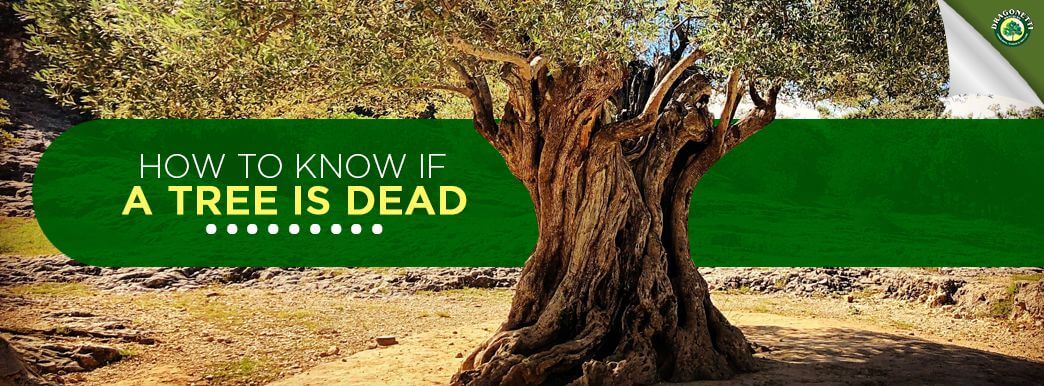
Deciding when it’s time to cut down a tree can be difficult. It’s easy to grow attached to a tree in your yard, as they’re beautiful and beneficial — plus, they add value and interest to your property.
However, the most difficult part of tree removal is knowing how to tell if a tree is dead and if there are any potential hazards associated with the tree.
WHEN SHOULD I CUT DOWN A TREE ON MY PROPERTY?
The first and most important step in knowing when to remove a tree is evaluating its health and checking for signs of decay. Try to determine how close the tree is to your house, driveway, power lines or other structures.
Finally, look closely at the tree itself. Is it healthy and thriving? Is it showing signs of stunted growth or disease? It may be time to remove the tree if:
THE TREE IS DEAD OR AT RISK OF FALLING
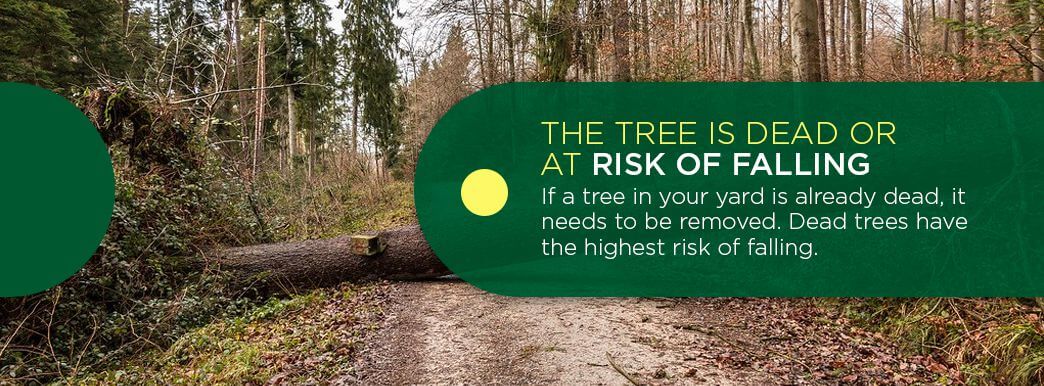
If a tree in your yard is already dead, it needs to be removed. Dead trees have the highest risk of falling. They also attract insects to your yard. Removing dead trees frees up space to plant new, healthier ones that can thrive for years to come.
If a tree in your yard is at risk of falling, you must remove it right away. Stray limbs — or even the tree itself — can significantly injure or damage you, your loved ones, your property or your neighbors. You must have dangerous trees removed from before a big storm, as the winds and rain will continue to weaken the tree until it topples.
THE TREE THREATENS IMPORTANT STRUCTURES
If a tree is growing too close to your house or another standing structure, you may need to consider removing it, especially if you live in an area that gets a lot of heavy storms or wildfires. Strong winds and rains can knock a weak tree onto your home. During a wildfire, the closer a tree is to your home, the more it’s at risk. When a tree is growing close to your house, you also provide rodents and insects easy access into your home.
Established trees may have been planted long before the power lines in your neighborhood were installed. Trees often grow tall or broad enough that they can damage power lines. This can cause problems with your neighborhood’s electric access and overall safety.
Be cautious of any trees growing near your driveway or any place you park a vehicle. Aside from weather-related threats, loose tree branches or tree nuts can pose a significant threat to your car.
Don’t forget about the parts of the tree you can’t see — if a tree is growing too close to your home, its extensive root system could damage your drainage pipes, causing costly leaks. Be sure you are pruning and maintaining your tree regularly to limit the threat to your property.
THE TREE IS DISEASED
Symptoms of a diseased tree include a soft tree trunk, soft roots and the presence of mushrooms or other fungi. The sicker a tree is, the more susceptible it is to breaking or falling. Contact a professional tree removal service to help you eliminate diseased trees and prevent the disease from spreading to other trees and plants on your property.
NEARBY TREES ARE SUFFERING
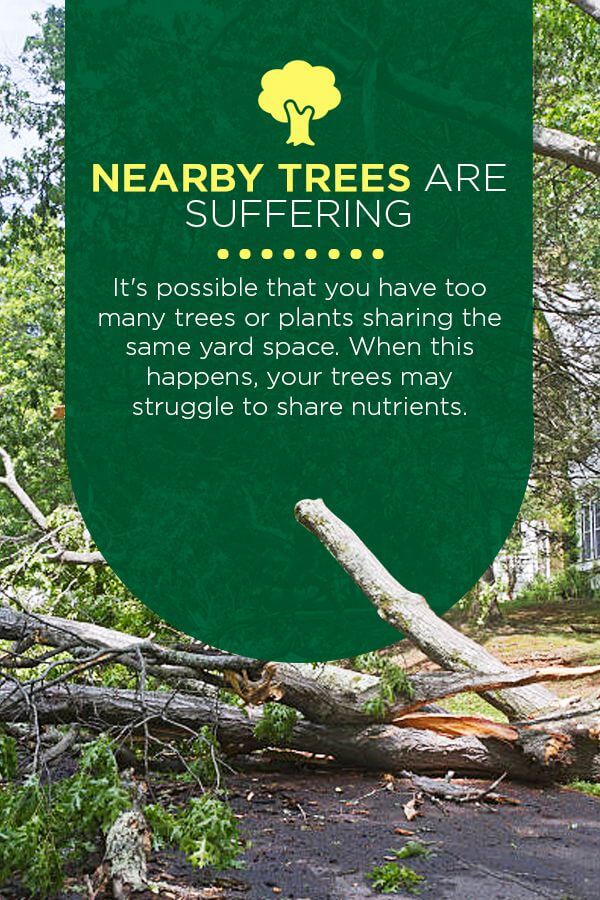
You may have too many trees or plants sharing the same yard space. When this happens, your trees may struggle to share nutrients. If you have a consistent problem with weak or dying trees, you might need to consider removing one or more to leave more nutrients for the others.
Contact a professional arborist or tree expert to help you figure out when to cut down a tree.
THE TREE IS NOT GROWING WELL
There are a few reasons a tree may not grow well in your yard:
Something is wrong with the tree: Sometimes, a tree is not strong enough to establish a healthy root system or fight off parasites. A weak tree may show signs of stunted or paused growth before eventually decaying.
There is not enough space: It’s possible your tree is healthy but lacks the appropriate amount of space to establish its intricate root system completely.
The conditions are not right: Many environmental factors can impact your tree’s ability to flourish, including climate, quality of the soil, moisture levels, the local ecosystem and more.
HERE’S HOW TO TELL WHEN A TREE IS DEAD
A dead tree needs to be removed immediately to prevent damage to you or your property. The best way to tell if a tree is alive or dead is to schedule regular, preventative maintenance for your yard. Have a professional tree company come to your home and perform a wellness check on your trees periodically. Then, should something change, you will know what to expect and how to handle it.
If you are monitoring the health of a tree on your own, keep a record of any changes you notice in your tree’s appearance. Watch out for signs that indicate your tree is dying. Track these changes and record whether they worsen or improve over time.
To tell if a tree is dead — or in the process of dying — determine whether symptoms of decay are present or worsening. To see if a tree is dead, look out for:
- A leaning trunk: While naturally leaning trees are no cause for concern, trees that were once straight and are now leaning may be decaying and at risk for falling.
- Rotten or damaged roots: Symptoms of root rot include a soft trunk, fungi growth, premature autumn coloring and loose bark.
- Falling or dead branches: If the branches on your tree are dead or frequently break loose, it’s a sign of a more significant problem, and you may need to remove the tree.
- Missing bark: Weak spots in your tree trunk — like cracked or missing bark — may be an indication of a weak tree.
- Tight branches: If your tree’s branches are growing in a tight, v-shaped formation — rather than the typical u-shape — it may have weak branches that are at a greater risk for splitting and falling.
- Early coloring: If your tree’s leaves are dying earlier than usual or turning an autumn color in warm months, this could indicate a larger problem.
WHEN IS IT TIME TO CUT DOWN A TREE ON YOUR PROPERTY?
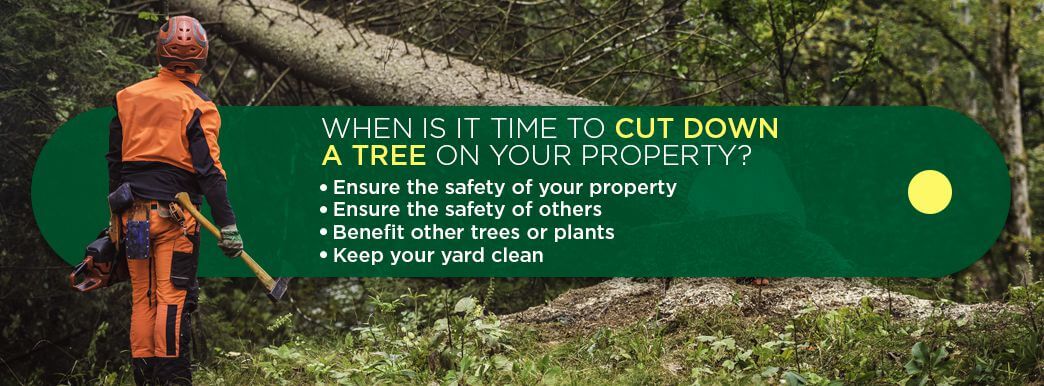
Learning how to check if a tree is dead is challenging. However, knowing when to cut down the tree is even more so. There are several reasons someone would cut down trees on their property. For example, removing a tree could:
Ensure the safety of your property: A tree can fall and crush fences, electric poles, cars, garages or even the roof of your home. If a tree threatens the well-being of your property, it’s better to remove the tree and avoid costly damages.
Ensure the safety of others: Trees can pose a threat to your loved ones, especially if you live with children or elderly people. Parents concerned about their children playing in a tall tree may want it removed. Similarly, a tree could interfere with the line of sight between your home and a busy road or the place where your children play. Households with older adults will want to be careful about having trees with extensive above-ground root systems, as they can easily trip and injure someone.
Benefit other trees or plants: Eliminating one tree may save several others. If trees in your yard are competing for the same nutrients, taking one out leaves more to be shared among the remaining, resulting in stronger and healthier trees.
Keep your yard clean: Sometimes, trees can cause an unwanted mess, especially for business owners trying to present a safe, clean property to their customers. Although beautiful, trees can often litter your yard with unwanted tree nuts, sap or debris. They also provide shelter to rodents or small animals that can cause problems around your property.
WHAT TIME OF YEAR IS THE BEST FOR TREE REMOVAL?
If you have decided a tree in your yard needs to be removed, you are probably wondering when is the best time to do it. Regardless of why you are removing it, the best time to cut down a tree is in the late winter.
Winter is the best time to remove trees because they are in a dormant state. A dormant tree is leafless and lighter, and therefore easier to remove. Winter is also the best time to prune a tree, as it puts less stress on your tree and minimizes wounds.
Learning how to tell if a tree is dead in winter is the same as learning how to tell in the warmer months. In some aspects, it’s simpler because the lack of leaves makes it easier to study the taller parts of the tree.
FREQUENTLY ASKED QUESTIONS ABOUT DEAD TREES
Dead or dying trees are a concern for many home and business owners. Some common questions people ask about dead trees are:
WILL A TREE REGROW ONCE IT’S CUT DOWN?
It’s possible your tree can regrow once cut down, depending on the type of tree, the growing conditions and how much of the tree was removed. Even if you only leave a tree stump behind, a new tree can sprout and grow over time.
IS THERE ANY WAY TO SAVE A DYING TREE?
In some cases, it may be possible to save a dying tree. When you first notice symptoms of tree decay, take steps to promote the health of your tree. Do this by providing proper hydration, fertilization with other nutrients and removing any insect infestations. It may also be possible to transplant your tree. However, if your tree is diseased, it’s in your best interest to remove it entirely and plant a new one in its place.
CAN I REMOVE A DEAD TREE MYSELF?
Removing a tree yourself can be a dangerous and costly decision. Once you cut a tree, you have no control over where that tree will land. Not only could this result in injury to yourself or others, but it can also cause expensive damages to your house, vehicle, electric lines or neighboring properties.
The safest and easiest way to remove a problematic tree from your yard is by hiring a professional service to take care of it for you.
WHAT SHOULD I DO WITH THE REMAINING STUMP AFTER A TREE IS REMOVED FROM MY YARD?
Once a tree is removed from your yard, you’ll want to have the stump removed as well. A left-behind tree stump:
- Attracts insects: If you leave a tree stump in your yard, it will slowly rot away. As it does, it will attract bugs, parasites and other pests to your yard. These insects are annoying and pose a threat to your remaining plants.
- Is hazardous to people walking in your yard: Children playing in your yard — or guests who are unfamiliar with the layout of your property — could easily trip over a tree stump.
- Makes mowing your lawn difficult: If you leave a stump in your yard, it will be difficult to navigate around while mowing or doing other landscape work.
- Could lead to tree regrowth: A stump can sprout tree regrowth. If you remove the tree to avoid damaging your home or power lines, this could be a problem in the future.
To avoid these issues, have your TREE OR STUMP REMOVAL SERVICE grind the stump for you during the removal process.
THERE IS A DEAD TREE IN MY YARD. WHAT SHOULD I DO NEXT?
Finding out your tree is dead is only the first step. The next step is to contact an experienced tree removal business. A tree removal service is equipped with the necessary tools and knowledge to safely remove your tree while minimizing the impact on your home, yard and daily routine.
SCHEDULE AN APPOINTMENT WITH DRAGONETTI TREE REMOVAL TODAY
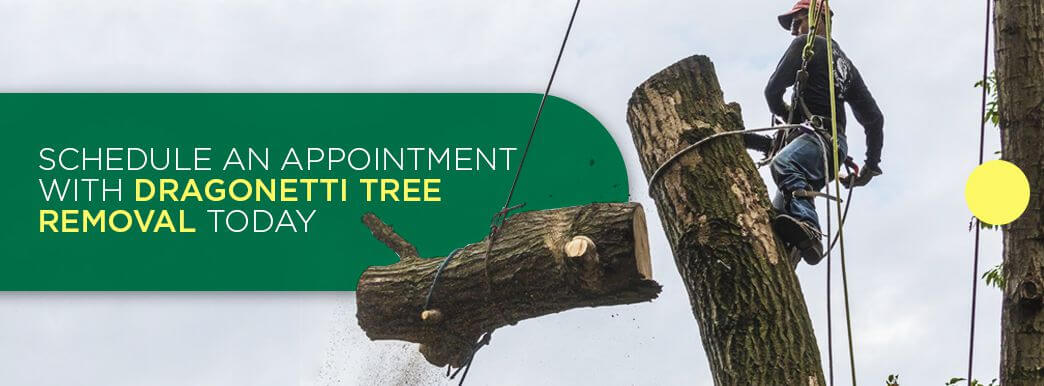
If you’re looking for professional tree care advice and services regarding your dead or dying tree, contact the experts at Dragonetti Tree Removal today. We are happy to answer any questions you may have regarding tree and landscaping maintenance.
